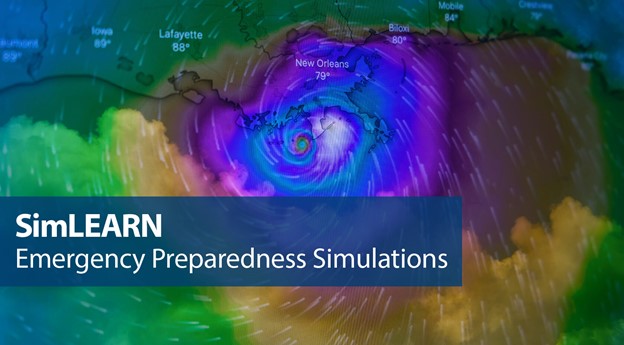In this four-part series on VA’s Emergency Preparedness Simulation efforts, you’ll learn how simulation and emergency preparedness professionals are using simulation to build collective strategies that mitigate, prepare, respond and recover from tragedies impacting Veterans and their communities, helping to fulfill VA’s commitment to Veteran care and its Fourth Mission.
The final installation of this series explores how simulation experts within the Simulation Learning, Evaluation, Assessment and Research Network (SimLEARN) and throughout the VA enterprise use full-scale exercises in preparing for potential emergencies that impact the lives of Veterans and the operations of society. The previous articles in this series provided an overview of how simulation is used to prepare health care facilities and professionals across the Veterans Health Administration (VHA) enterprise, described how simulation professionals use tabletop exercises, and explored how functional exercises are utilized to test the durability of VA health systems.
Full-Scale Emergency Preparedness
Full-scale exercises are comprehensive simulations that incorporate significant planning and coordination across a wide range of partner organizations and programs that respond to emergencies. Although they can be difficult to plan, full-scale exercises hold great value to health care organizations. They engage them—such as a local VA Medical Center—with total immersion into a multi-layered scenario to test the several elements of its plan.
The full-scale exercise usually incorporates engaging other response agencies and community partners to replicate the coordination necessary to employ shared assets in an emergency response. The scenario is shaped with continuous injects, or surprise scenario amendments/additions that drive exercise participants to enact a plan or process. Those scenario changes are designed to pressure the command structure of the organization to manage the response to an emergency with all its systems engaged in addressing threats and impacts of the event.
In this simulation practice, it is all hands-on deck. A complex scenario will test the organization’s ability to develop a planned response, employ staff and resources, and coordinate with key internal and external players to engage a comprehensive response to a larger scale emergency incident.
In planning full-scale exercises, the planning team will select an exercise director who is responsible for coordinating with participants to identify the key objectives for the simulation. Partner organizations will identify specific aspects of the planning and capabilities they would like to test or evaluate and choose a significant hazard that will help shape a scenario. This can be challenging with partners that span across different organizational systems and government services, as the emergency scenario needs to reasonably threaten each partner’s operations in a manner that will drive the activation of their plans in a practical way. If the scenario design struggles to reach across the spectrum of response capabilities, it could create obvious exaggerations in the simulation and cause partners to miss cues that would cause them to activate specific parts of their emergency plans.
Once the general scenario is agreed upon, the exercise planning team will collaborate on developing key consecutive activities that will simulate actions in the emergency incident. The end-product is commonly referred to as the Master Scenario Events List (MSEL). The MSEL will drive the simulated event from the beginning through to the final resolution of the threat.
Emergency Preparedness Keeps Everyone Safe
As mentioned in the first part of this series, no matter which type of emergency preparedness simulation is being used, emergency management teams evaluate participant actions in the simulations once they are completed. They assess plans and procedures for effectiveness in responding to that specific emergency and whether the organizations have the proper resources available.
No person or organization wants to experience the worst day of its existence. However, catastrophic events continue to take place around the world and all entities in every industry, as well as the citizens who live in our communities, must recognize that planning and preparedness is the key to surviving these threats. Plans are developed to initiate the response to these identified hazards, but they must be tested to determine if they help effectively guide the organization through a process to identify and mitigate the hazards to life and safety, reduce or defend against damage to property and systems, and allow for the continued execution of essential operations while the emergency persists.
While no amount of planning can prevent an event or hazard from affecting an organization, emergency preparedness simulation provides opportunities to minimize loss and disruption through preparation with the goal of keeping Veterans, their families, and communities safe.
Topics in this story
More Stories
Study underscores important role COVID vaccination can have in protecting Veterans from infection and reducing long-term health consequences
Columbia VA’s robotic surgery teams completed their 800th robotic surgery and are on schedule to hit 1,000 by the end of the year.
In a decentralized clinical trial, Veterans can participate from their own homes or local VA instead of having to travel to a research site.







I just wrote a note about what the VA was doing about real time post disaster activity. Looks like I should have read the whole list of articles.